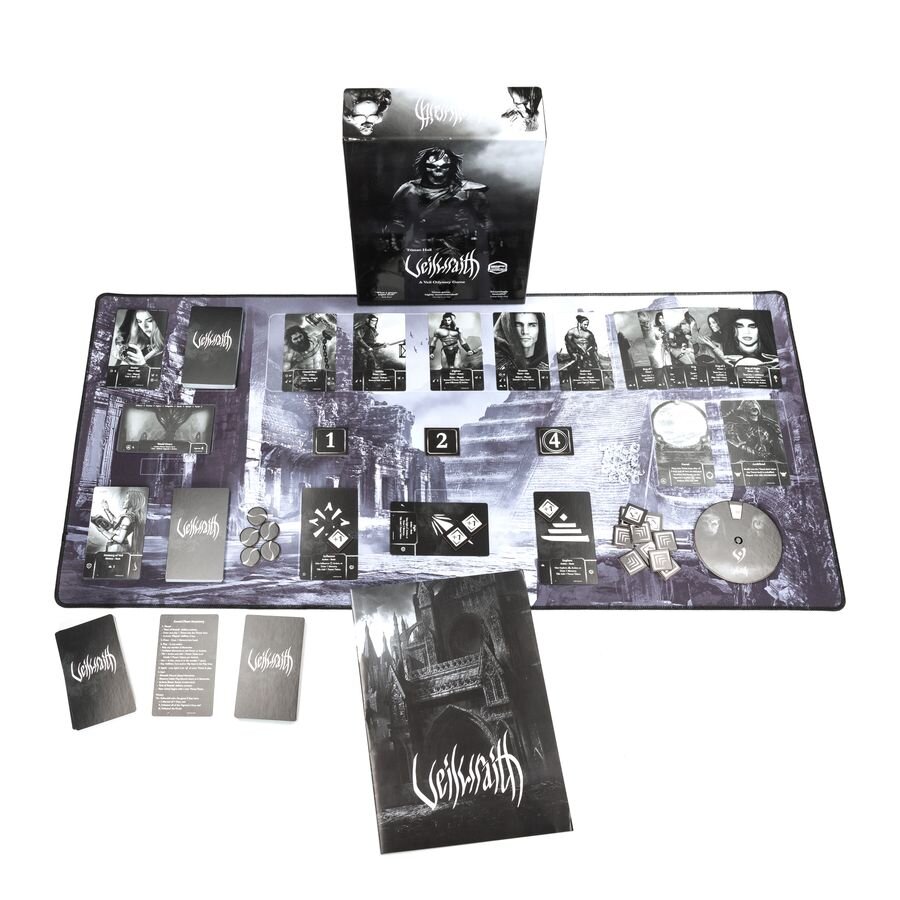Veilwraith – First Impressions
Review copy provided by the publisher
Veilwraith is the latest card game from designer Tristan Hall and his publishing company Hall or Nothing Productions. It’s a solo fantasy adventure set after the end of the world, but it can also support multiple players if you have more than one copy of the game. Veilwraith will certainly appeal to fans of the Kilforth games. For those unfamiliar with that series, though, the game incorporates light deckbuilding, rotating action selection, and striking visual illustrations—all of which might be enough to interest gamers who haven’t tried other Tristan Hall designs.
It’s a fast-playing solo experience that can be finished in about 30 minutes (maybe just a bit longer if the Vignette is tough and players have to introduce the Archfiend).
For those who already appreciate the Kilforth series from Hall or Nothing Productions, Veilwraith will still surprise with its new mechanics and gloomy take on how life goes on after the end of the world.
What It Does
The hush settled across the land beneath the obsidian skies. The fighting had all but ceased. There was a hissing from the trees as they recoiled from the broiling mists, their branches curling up and twisting into ash, then blowing away on the breeze. As the stars faded in the sky the terrible silence was deafening.
Suddenly, a depthless chasm ripped the ground asunder as though giant hands had torn the earth apart. Buildings and entire streets buckled and fell into the abyss along with screaming hordes of bodies. The plates of the earth shrieked and shifted, and as the giant mountains of land that had been thrown into the sky descended a fathomless ash cloud filled the air.
And so the world ended.
But the world ends all of the time, right? In movies, in books, in games. Incalculable in number, innumerable in the method. The story is never finished, though, so even when the world ends something happens afterward.
And in Veilwraith that something is more like someone, a spirit trapped behind the Veil who is compelled to use snippets of memory and slivers of light to pierce the darkness and fight back against the threats that overwhelm and harry any who might try to escape the Veil.
As you’d expect from a game designed by Tristan Hall, the mechanics are accompanied by gorgeous artwork that makes you stare somberly at each image before moving on with the game. And once you’re done ogling the optical delights, there is a nail-biting campaign ahead that could very well end in failure.
In the Vana lands, there are Deja, Anima, and Foe—all trapped beyond the Veil like the wandering Wraith—who must be quelled. During a game of Veilwraith, players will use their Memories to defeat any Threats while pursuing lost Keys that will unlock the Portal and allow for escape from the Veil.
Played over a series of Vignettes, the campaign is an adventure that tests a player’s ability to manage their deck and their action choices in an increasingly narrow trajectory toward victory. As the Vignettes continue, Foes become more prevalent, Threats become more relentless, and the onward pull for the Wraith to escape out of the Portal becomes more desperate.
How It Does It
A Vignette is the micro setting for each game of Veilwraith. It provides the Threats that will be shuffled into the main deck, as well as the fearsome Foes that must be vanquished in order to leave safe in the knowledge that the Veil is a shade safer.
The Vignettes progress into each other and grant the player a reward for successfully completing it. Each Vignette will introduce any variations on the main gameplay outside of the Threats and Foes that are shuffled together with the Keys.
The Keys are the fragments of humanity and sanctuary in the Veil and all five of them must be collected in order to secure a path to the Portal. Keys are shuffled in with the Threats and the Foes and require actions for players to obtain them.
Thankfully, Keys do provide a respite from the dark and dangerous corners of the Veil. Players must be wise when deciding the best time to call upon these spiritual favors. Using them in the right moments can be the difference between victory and defeat.
There are Threats, who will never stop appearing in the Veil, and then there are Foes, who represent the greatest physical obstacles in the path of the Veilwraith. Foes take more time and energy to defeat while simultaneously draining the resources and spiritual energy of the Wraith.
Each Vignette will have certain Foes shuffled into the main Threat deck and these Foes—like the Keys—must all be defeated and accounted for before escape is an option. Similar to the Keys, the manner in which these are considered and confronted is important to the survival of the Veilwraith.
Here’s how it all coalesces:
Grab a Vignette. Create stacks of cards for the Threat deck using the Keys and the Vignette’s foes. Fill the stacks with the remaining Threats from the Vignette. And then compile all the stacks into one Threat Deck.
The player will then draw one Threat each turn and one Memory. Use the powers and abilities of these Memories in combination with one or more of the three available actions—Explore, Fight, and Influence—to remove Threats, defeat Foes, and collect Keys.
Escape out of the Portal when all Foes are defeated and all Keys are collected.
On their turn, players can use Memories to perform unique actions or to buff the power of the three main actions. Exploring helps to collect Keys and defeat certain Threats. Fighting and Influencing are the primary ways to defeat the rest of the Threats and Foes who might appear. And then all three actions can be used generally to draw more Memories.
Here’s the kicker, though. Unless a card ability or Key power allows you to perform an additional action, you can only use one of the three actions each turn, and activating an action changes up the order and positioning of the three actions and their respective power levels. So it’s a clever little card dance that players will learn to jig by balancing where the action cards are and which power is the most valuable to use at any given time.
Why You Might Like It
Veilwraith sets up quickly, plays smoothly, and poses a challenge to players while doing so. All of that is advantageous for a solo game or something that you want to play more than once in a single sitting.
The artwork is sumptuous, the mechanics are simple yet satisfying, and the scale of difficulty that players can explore is vast.
Why You Might Not
If you’re buying the base game, there are only five Vignettes to tackle as a Veilwraith. That’s not a lot, especially given that the expansion adds on 15 more Vignettes, as well as many more Threats and Foes.
This means that if you just own the base game, what you’re exploring more is the varying degrees of difficulty in approaching the content rather than the volume of content in the game.
Final Thoughts
I like a lot of what’s happening here. The restriction on what I can do each turn makes tough choices that are rewarding as a player. Choosing to Use one action while Tilting (slightly increasing the power) another action might help me this turn, but it could hurt me on the next turn. It’s hard to tell sometimes.
And the way that a Used action is pushed to the beginning (and weakest power level) of the line means that you want to be sure that you’re activating the right actions in the right order so that you’re not left high and dry on a turn when a big obstacle arrives from the Threat deck.
I adore the aesthetic of the game, as well. Black-and-white games can really stand out when they’re done well. My first big experience with them was the Escape the Dark series, but I’m definitely enjoying how Veilwraith looks on the table.
Every time I set it up, I was excited to get going and I frequently thought about playing a second time whenever a game would end. That’s a good sign for me.
Veilwraith is a very satisfying game, but there are some suggestions I would make to increase the likelihood that you will enjoy the game.
If you get the game, I’d recommend getting the Absolution expansion as well. I only have the base game and I don’t imagine it has a lot of longevity with just the main 5 Vignettes that come in the box. There aren’t different “characters” to play or additional story revelations to explore. What players will tinker around with is the difficulty. Playing it on harder variants that allow less wiggle room for failure, if any. That’s what would keep someone coming back to the main content. With the Absolution expansion, however, you’ve suddenly got 20 Vignettes that you could move through, greatly increasing the variety of the campaign and the length of time that you can delve into the dark world of Veilwraith. That’s what I would recommend from the start.
For those having trouble with how hard the game is, I’d offer up a slight modification to the game’s recommendation for trying Easy Dream mode. In Easy Dream mode, players are encouraged to select one of the three Action Power Tokens (1,2, and 3) and flipping it onto its advanced side. That would create a combination of either (2, 2, and 3), (1,3, and 3), or (1,2, and 4). I haven’t tried the (1,2, and 4) alternative, but I would caution players against the (1,3, and 3) variation, which is what I tried. It swings the game too heavily in the other direction. I breezed through Vignettes 2-5 without going below 10 Spirit ever, versus the original game difficulty I played at where I lost Vignette 2 three different times, albeit by a very close margin. I think the (2,2, and 3) option would be a good starting point if you’re having trouble in the regular mode.
Those are my two biggest remarks that I’d want to know if I was jumping into the game blind. Get all of the Vignettes in one fell swoop in order to enjoy it all and experience the big campaign and then be careful how you modify the difficulty of the game because if you’re not careful it can pivot very quickly in the other direction.
All in all, though, Veilwraith is aesthetically mesmerizing, mechanically intriguing, and deceptively addictive. I think it’s a solid design from Tristan Hall and I hope I have the chance to see more in the future. For someone who isn’t typically a solo gamer, it’s a great game (among others) that has helped me to reconsider that mindset.
If you want to check out Veilwraith, you can visit Hall or Nothing Productions or read what the community thinks on BoardGameGeek.
This is a solo game full of rich worldbuilding and scalable difficulty. Sound like something you’d like?
Let us know in the comments and give a recommendation for other games of which to share our first impressions.







